
David Warren Brubeck was an American jazz pianist and composer. Often regarded as a foremost exponent of cool jazz, Brubeck's work is characterized by unusual time signatures and superimposing contrasting rhythms, meters, tonalities, and combining different styles and genres, like classic, jazz, and blues.

Joseph Albert Morello was an American jazz drummer best known for serving as the drummer for pianist Dave Brubeck, as part of the Dave Brubeck Quartet, from 1957 to 1972, including during the quartet's "classic lineup" from 1958 to 1968, which also included alto saxophonist Paul Desmond and bassist Eugene Wright. Morello's facility for playing unusual time signatures and rhythms enabled that group to record a series of albums that explored them. The most notable of these was the first in the series, the 1959 album Time Out, which contained the hit songs "Take Five" and "Blue Rondo à la Turk". In fact, "Take Five", the album's biggest hit was specifically written by Desmond as a way to showcase Morello's ability to play in 5
4 time.

At Carnegie Hall is a jazz live album by the Dave Brubeck Quartet. It was recorded at the famed Carnegie Hall in New York City on Friday, February 22, 1963. Critic Thom Jurek described it as "one of the great live jazz albums of the 1960s". Critic Jim Santella wrote, "This is timeless music from a classic ensemble. Goosebumps are guaranteed."
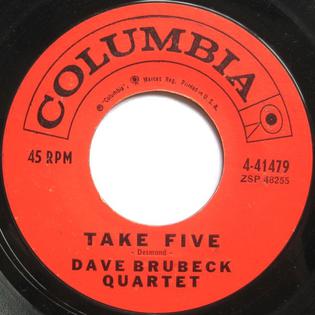
"Take Five" is a jazz standard composed by Paul Desmond. It was first recorded in 1959 and is the third track on Time Out by the Dave Brubeck Quartet. Frequently covered by a variety of artists, the track is the biggest-selling jazz song of all time and a Grammy Hall of Fame inductee.
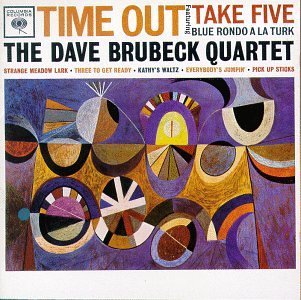
Time Out is a studio album by the American jazz group the Dave Brubeck Quartet, released in 1959 on Columbia Records. Recorded at Columbia's 30th Street Studio in New York City, it is based upon the use of time signatures that were unusual for jazz such as 9
8, 6
4 and 5
4. The album is a subtle blend of cool and West Coast jazz.
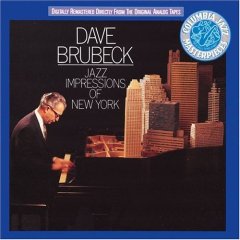
Jazz Impressions of New York is a jazz album released by Dave Brubeck. The compositions were for the television show Mr. Broadway.
"Blue Rondo à la Turk" is a jazz standard composition by Dave Brubeck. It appeared on the album Time Out in 1959. It is written in 9
8 time, with one side theme in 4
4, and the choice of rhythm was inspired by the Turkish aksak time signatures. It was originally recorded by the Dave Brubeck Quartet with Dave Brubeck on piano, Paul Desmond on alto saxophone, Eugene Wright on bass, and Joe Morello on drums.

Time Further Out is a jazz studio album by the Dave Brubeck Quartet released by Columbia Records in November 1961. It features the "classic" lineup of the quartet: pianist and leader Dave Brubeck, alto saxophonist Paul Desmond, bassist Eugene Wright, and drummer Joe Morello. The album was recorded by engineer Fred Plaut and produced by Teo Macero.

Bernstein Plays Brubeck Plays Bernstein is a 1961 studio album by The Dave Brubeck Quartet. Its title refers to the fact that it consists of both a Brubeck composition conducted by Leonard Bernstein and Bernstein compositions played by the Dave Brubeck Quartet. The title is also an echo of Dave Brubeck's 1956 solo debut album, Brubeck Plays Brubeck.

Gone with the Wind is a jazz album released by The Dave Brubeck Quartet in 1959 on Columbia CL 1347 (monophonic) and CS 8156 (stereo).

Time In is a 1966 studio album by Dave Brubeck, the last of Brubeck's 'Time' series.

Jazz Impressions of the U.S.A. is a studio album by Dave Brubeck Quartet.

Countdown—Time in Outer Space is a studio album released by the Dave Brubeck Quartet in 1962 on Columbia LP record CS 8575 (stereo) and CL 1775 (mono). The front cover features the 1959 painting Orange and Black Wall by Franz Kline. In Australia the album appeared on the Coronet label. It was re-released, for the first time in digital format, in 2004 as part of a compact disc collection titled Dave Brubeck: For All Time. It was again released as part of the box set The Dave Brubeck Quartet: the Columbia Studio Albums Collection 1955-1966. Both CD re-releases feature a bonus track titled "Fatha".
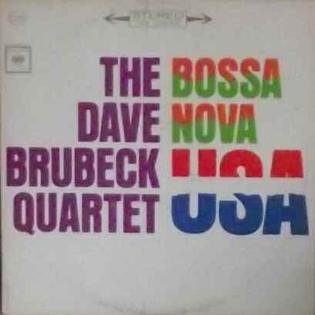
Bossa Nova U.S.A. is a studio album released by the Dave Brubeck Quartet in 1963 by Columbia originally in the United States as LP record CS 8798 (stereo) and CL 1998 (mono) and in England as SBPG 62127. It was also released by CBS in Australia, as catalog SPB 233.038.
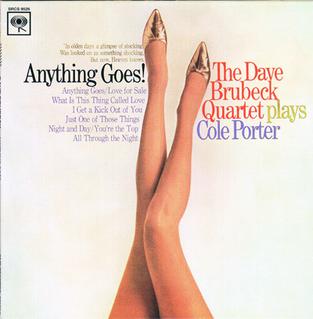
Anything Goes! The Dave Brubeck Quartet Plays Cole Porter is a 1967 studio album by Dave Brubeck and his quartet of music by Cole Porter, recorded between December 8, 1965 and February 17, 1966.

Brandenburg Gate: Revisited is a studio album by The Dave Brubeck Quartet accompanied by an orchestra arranged by Howard Brubeck.

Brubeck in Amsterdam is a 1962 live album by Dave Brubeck and his quartet recorded on 3 December at the Concertgebouw in Amsterdam, though unreleased until 1969. Six of the tracks are from Brubeck's musical The Real Ambassadors.

Bravo! Brubeck! is a 1967 live album by Dave Brubeck and his quartet, recorded during their tour of Mexico. The quartet were augmented by Chamin Correa on guitar, and the bongo and conga player Salvatore Agueros. It was released in 1967.

Jazz: Red Hot and Cool is a jazz live album by The Dave Brubeck Quartet. It was recorded during one 1954 and two 1955 performances at the Basin Street East club in New York City. Released originally in 1955, this album was remastered and reissued in 2001, while adding two tracks that were not included in the original album.

Brubeck à la mode is 1960 studio album by pianist Dave Brubeck and his quartet.

















